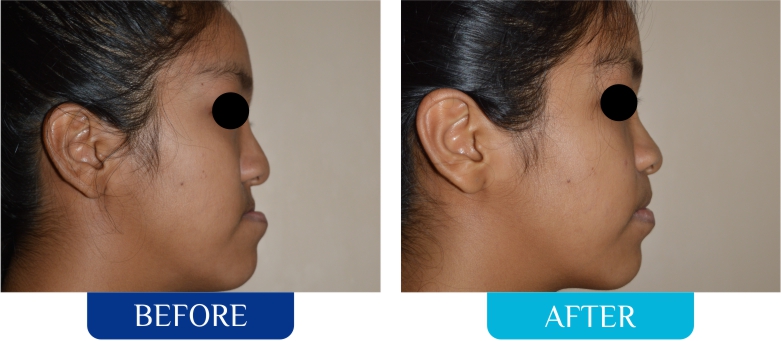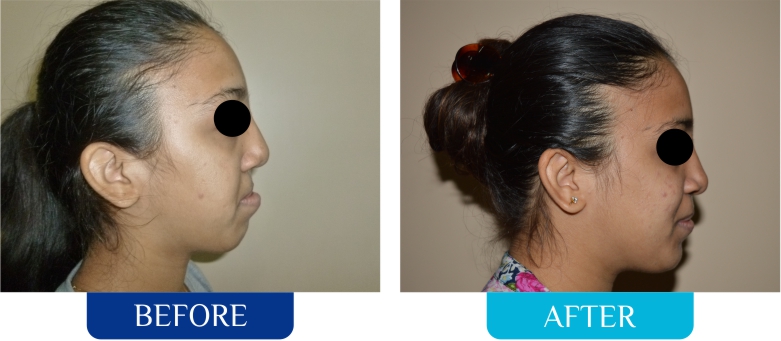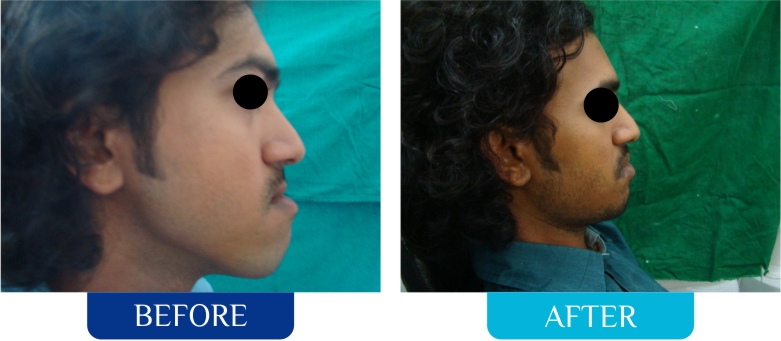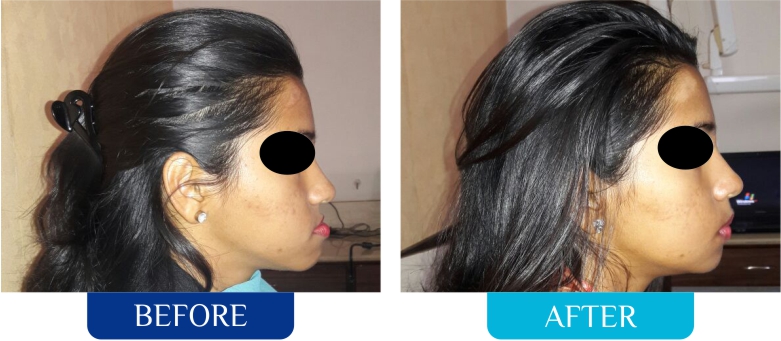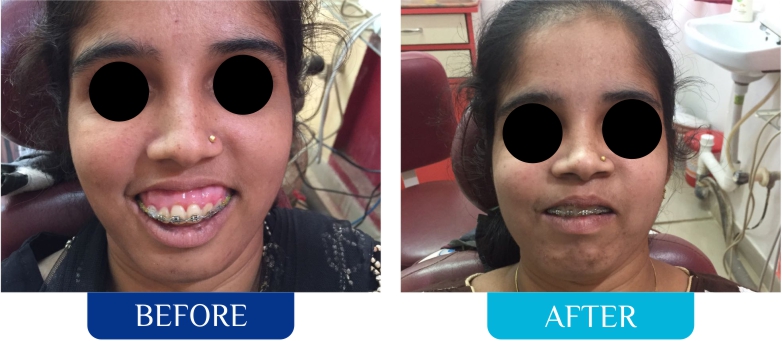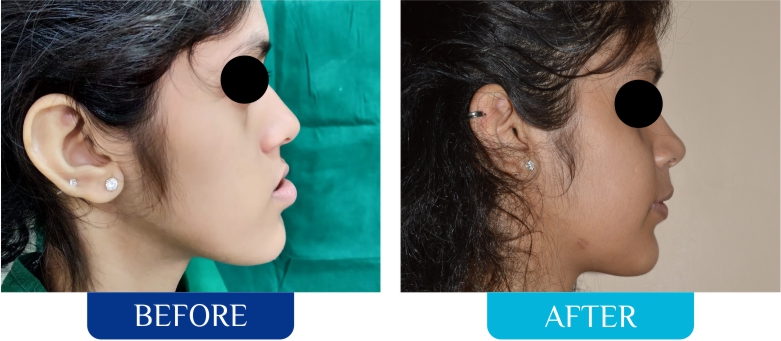Orthognathic Surgery & Distraction
Osteogenesis ( Jaw Deformity Correction)
Jaw deformity can result from previous trauma (fractures of the jaw), cleft lip and palate or jaw joint disorder (TMJ ankylosis). It not only affects the adolescent patient functionally and cosmetically, but also psychologically. It has a great impact on the young minds as they get mocked at school and in friends. It can manifest as either an overgrown / undergrown upper and / or lower jaw i.e. the upper jaw and / or lower jaw are placed forward or backward giving the patient a deformed look. Sometimes the jaw joint gets fused to the skull bone and this not only prevents the patient from opening the mouth but also affects growth of that side of the lower jaw and the patient has a crooked and asymmetric face leading to embarrassment.
Most of the times correction of these deformities involves orthodontic treatment of the teeth (with braces) to change tooth position to make surgery more predictable. At times the treatment with braces can be done post surgery also.
When the upper jaw is of a larger size there is excess visibility of the gums and teeth while talking and laughing and this gives the patient a and appearance. This can be corrected by surgically cutting the upper jaw and reducing its height and then fixing it up in its corrected position with Titanium plates and screws. This surgery is called “Le Fort I Superior repositioning”. The entire surgery is done from within the mouth and there is no cut or stitch on the face and is hence acceptable cosmetically.
When the lower jaw is larger than normal, it gives the patient an aged look and the teen looks much older than their age. To correct this deformity, again the surgery is done from within the mouth and the posterior part of the lower jaw is cut and the lower jaw pushed back to reduce the length so as to achieve a normal size and appearance. This surgery is called “Bilateral Sagittal Split Osteotomy – setback”. Even here the bone is fixed in its place by Titanium plates and screws.
Sometimes just the chin is either larger or smaller and needs surgical correction. It is called “Genioplasty”. The chin bone is cut from within the mouth and repositioned to increase or decrease the size as planned and fixed with Titanium plates and screws.
In cleft patients the upper jaw usually fails to grow to a normal size due to scarring of the palate or due to innate deficiency of tissues. This gives the patient a dish faced deformity. In the cleft patient routine maxillary advancement surgery is difficult due to scarred palatal tissues. In these patients a procedure called “Distraction Osteogenesis” is performed to increase the size of the upper jaw and form new bone. This is not done routinely by surgeons as it needs special training and expertise and only a handful of surgeons perform this complex surgery on a regular basis. Dr Nisheet Agni has been performing these surgeries since last 10 years successfully year after year. He also has an International Publication in an American Journal describing the technique.
Similarly in cases of TMJ (jaw joint) ankylosis the lower jaw fails to grow and hence depending on whether one side or both sides are affected the patient might have a lower jaw which might be smaller on both sides or only one side. In such cases the lower jaw is surgically cut and the distractor device fitted to perform the distraction procedure and increase the size of the lower jaw. This procedure can grow around 20 – 25 mm of new bone predictably.
Most of the times correction of these deformities involves orthodontic treatment of the teeth (with braces) to change tooth position to make surgery more predictable. At times the treatment with braces can be done post surgery also.
When the upper jaw is of a larger size there is excess visibility of the gums and teeth while talking and laughing and this gives the patient a and appearance. This can be corrected by surgically cutting the upper jaw and reducing its height and then fixing it up in its corrected position with Titanium plates and screws. This surgery is called “Le Fort I Superior repositioning”. The entire surgery is done from within the mouth and there is no cut or stitch on the face and is hence acceptable cosmetically.
When the lower jaw is larger than normal, it gives the patient an aged look and the teen looks much older than their age. To correct this deformity, again the surgery is done from within the mouth and the posterior part of the lower jaw is cut and the lower jaw pushed back to reduce the length so as to achieve a normal size and appearance. This surgery is called “Bilateral Sagittal Split Osteotomy – setback”. Even here the bone is fixed in its place by Titanium plates and screws.
Sometimes just the chin is either larger or smaller and needs surgical correction. It is called “Genioplasty”. The chin bone is cut from within the mouth and repositioned to increase or decrease the size as planned and fixed with Titanium plates and screws.
In cleft patients the upper jaw usually fails to grow to a normal size due to scarring of the palate or due to innate deficiency of tissues. This gives the patient a dish faced deformity. In the cleft patient routine maxillary advancement surgery is difficult due to scarred palatal tissues. In these patients a procedure called “Distraction Osteogenesis” is performed to increase the size of the upper jaw and form new bone. This is not done routinely by surgeons as it needs special training and expertise and only a handful of surgeons perform this complex surgery on a regular basis. Dr Nisheet Agni has been performing these surgeries since last 10 years successfully year after year. He also has an International Publication in an American Journal describing the technique.
Similarly in cases of TMJ (jaw joint) ankylosis the lower jaw fails to grow and hence depending on whether one side or both sides are affected the patient might have a lower jaw which might be smaller on both sides or only one side. In such cases the lower jaw is surgically cut and the distractor device fitted to perform the distraction procedure and increase the size of the lower jaw. This procedure can grow around 20 – 25 mm of new bone predictably.

